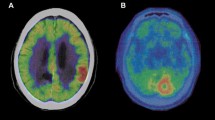Abstract
Background. This study was carried out to clarify the practical limit of the number of stereotactic radiosurgery (SRS)-targeted tumors based on the irradiation dose of normal brain tissues.
Methods. Twenty-five patients with multiple brain metastases who received SRS from October 1998 to May 2002 were enrolled in the study. In each patient, the treatment options were thoroughly studied before deciding upon a course of treatment. The number of irradiated targets was increased one by one until all of the targets were included in a treatment plan. Given a surface dose of 25 Gy, we calculated the dose volume histogram (DVH) for the entire brain in each treatment plan and compared it with those of other treatment plans. Ultimately, only 5 of the 25 patients received irradiation for all of their tumors; the others received selective irradiation targeting only those tumors that were causing symptoms.
Results. When the number of targets increased, the DVH curve shifted to the right. The volume of the brain irradiated at a dose of 5 Gy or higher was 25.7% or less for 4 or fewer targets, 45.7% for 5–6 targets, 81.0% for 7–8 targets and 100% for 9–11 targets. When the number of the targets exceeded 8, more than 50% of the entire brain was irradiated at levels of at least 8.7 Gy. The dose distribution became very complex as the number of targets increased. Although the survival time of the group in which tumors were selectively targeted was longer than that in the group in which all tumors were irradiated, the difference between the two groups was not statistically significant (P = 0.2537).
Conclusion. In SRS for multiple brain metastases, risks of both acute and late sequelae may increase because the exposure dose to normal brain tissues increases with increased numbers of target tumors. Dose distribution becomes more complex according to the increase in the number of targets. Based on our DVH curves, we conclude that the exposure dose to normal brain tissues is acceptable when the number of targets is less than 7. Importantly, our study also reveals that it may not be necessary or desirable to irradiate all metastatic tumors.
Similar content being viewed by others
Author information
Authors and Affiliations
Corresponding author
About this article
Cite this article
Takahashi, M., Narabayashi, I., Kuroiwa, T. et al. Stereotactic radiosurgery (SRS) for multiple metastatic brain tumors: effects of the number of target tumors on exposure dose in normal brain tissues. Int J Clin Oncol 8, 289–296 (2003). https://doi.org/10.1007/s10147-003-0331-y
Received:
Accepted:
Issue Date:
DOI: https://doi.org/10.1007/s10147-003-0331-y




